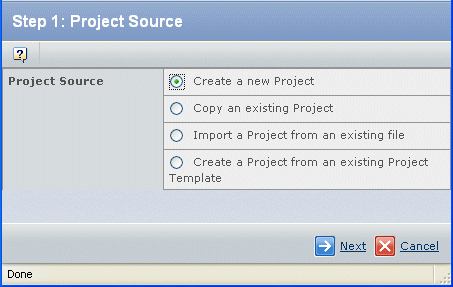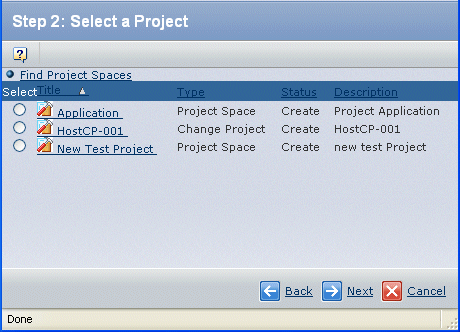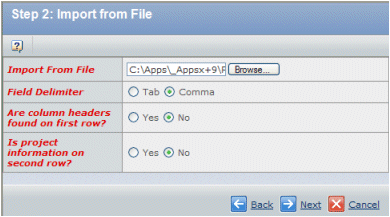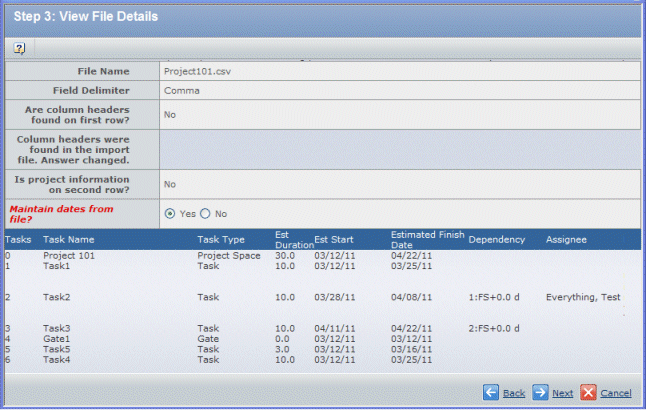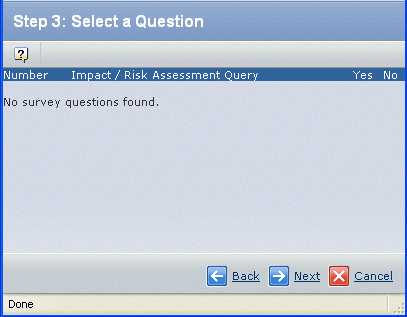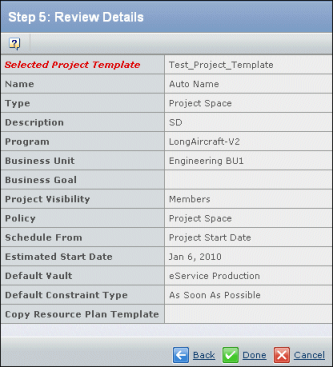Enter details for the project:
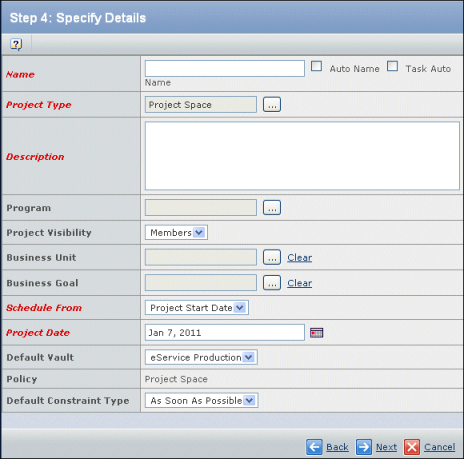
If you are copying a project, its details are defaulted
from the copied project. If creating a project from scratch, you must
enter its details.
Name. Enter the name of the
project. Click Autoname to have the system assign
the project name. If you are creating a project from a project template
you can click Task Autoname to autoname all the
tasks being copied from the project template. If Task Autoname
is not checked, all the tasks in the project will get the same name as
in the project template.
Project Type. Shows as Project
Space. If alternate types or subtypes have been defined for your system,
click  to select
a subtype. Only one subtype can be selected. The type selected determines
the policies made available in the Select Policy field and corresponding
attributes on the page. The type chooser is available only when there
is more than one type. If there is only one project type, this field
becomes a read-only field showing the project type.
to select
a subtype. Only one subtype can be selected. The type selected determines
the policies made available in the Select Policy field and corresponding
attributes on the page. The type chooser is available only when there
is more than one type. If there is only one project type, this field
becomes a read-only field showing the project type.
Description. Enter a brief
description of the project.
Program. Select one or more
programs to be associated with the project. Click
 and
then search for the program(s). For help, see Searching for Programs.
and
then search for the program(s). For help, see Searching for Programs.
Project Visibility.
- Company. All Program Central users in your
company can view the project by searching for it.
- Members. Only people added as project members can
view the project.
Business Unit. The business unit.
Click  to select
a business unit.
to select
a business unit.
Business Goal. The business
goal that this project fulfills. Only the host company can work with
business goals so the field is only shown for host company employees.
To associate a business goal with the project, click  . For
help, see Searching for Business Goals.
. For
help, see Searching for Business Goals.
Schedule From. Select an option
from the drop-down menu:
- Project Start Date. Schedule the project based
on when you start.
- Project Finish Date. Schedules the project based
on when it must be finished.
If you imported a file and maintained the dates to create
the project, you cannot change the Schedule From or Project Date values.
You can edit these values after the project is created.
Project Date. The date the project is estimated
to start or finish, based on the value of the Schedule From field. To
change the date, click
 (see Entering Dates Using the Calendar). When using a start date, the default is today's date.
Depending on how WBS tasks are added to the project, the tasks may take
on this date by default. For example, if you add tasks from scratch,
they automatically have the same estimated start date as the project.
For more information on estimated start dates, see Rules for WBS Task Fields.
(see Entering Dates Using the Calendar). When using a start date, the default is today's date.
Depending on how WBS tasks are added to the project, the tasks may take
on this date by default. For example, if you add tasks from scratch,
they automatically have the same estimated start date as the project.
For more information on estimated start dates, see Rules for WBS Task Fields.
Copy Options. Check "Include
All Related Projects" if you want the related projects copied to the
new project. This field appears only when copying a project.
Policy. Select the policy to
govern the project from the drop-down list. The policies in the list
are for the Project Type selected. If the type only has 1 policy, this
field is read-only.
Attributes. Depending on the
policy selected in the Policy field, one or more attribute fields may
display.
Server. (Available only
for the Semiconductor Accelerator for Enterprise Project Management)
The sync server to associate your project with a DesignSync vault.
For example, your DesignSync/ProjectSync server might be wiz.my_company.com:2647.
Path. (Available only
for the Semiconductor Accelerator for Enterprise Project Management)
The URL to your DesignSync vault, which must include the Projects
directory. The Path field is concatenated to the Server field. There
could be a case where the dsStore (Server) already has "Projects" in
its own Path.
Selector. (Available
only for the Semiconductor Accelerator for Enterprise Project Management)
The DesignSync selector, which displays "Trunk:Latest". Not editable.
Default Constraint Type.
The default constraint type for project tasks. If this is set to "As
Soon As Possible" the constraint type for tasks will default to "As Soon
As Possible". Otherwise, the default constraint for tasks will be "As
Late As Possible".
Copy Resource Plan Template. If a resource
plan template exists for the template, you can select it, which will
copy the resource plan when creating a project from the project template.
![]()
![]()
![]()
![]()
